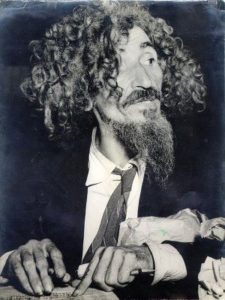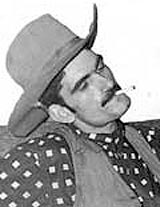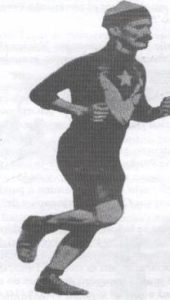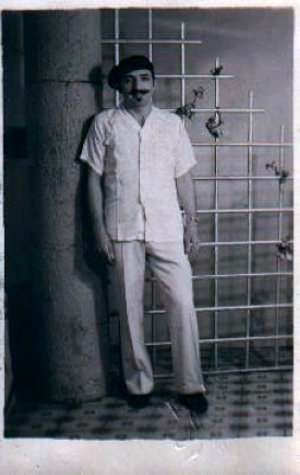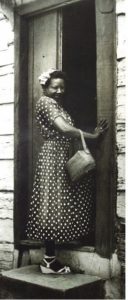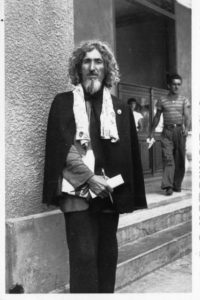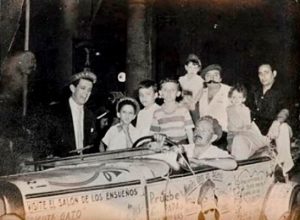 BIGOTE E’ GATO.. ES UN GRAN SUJETO QUE VIVE ALLÁ POR EL LUYANÓ…
BIGOTE E’ GATO.. ES UN GRAN SUJETO QUE VIVE ALLÁ POR EL LUYANÓ…
Bigote Gato se llamó, en realidad, Manuel Pérez Rodríguez y aunque sus padres fueron oriundos de Candamo, en Asturias, en realidad nació el 13 de diciembre de 1910 en la vecina localidad de Santullano de Las Regueras, donde dio los primeros pataleos para honrar a los viejos caballeros de la Batalla de Covadonga, y sobre todo, a las fresas, fabadas y sidras estupendas.
Según Rolando Aniceto que lo conoció : “Bigote llegó a La Habana en marzo de 1924, con catorce años, a bordo del buque Cristóbal Colón. Vino tras la huella del padre y, al final, se buscó un destino propio. Su primera ocupación fue en una fonda, donde ganaba veinte centavos al día. Sin embargo, hay más: fue guaguero, bodeguero, trabajó en una fábrica de hielo y se lució de lo lindo en los bares Cristina y Hatuey en Luyanó. Dio muchísimos traspiés; nunca puntapiés. Se empezó a hacer famoso en La Tropical como un gran bailador. Le llamaban el “Gallego Caramelo”, por pegajoso. En estas fiestas hizo muy buena liga con un carnicero lleno de dinero: este lo invitaba a beber y él le presentaba “jevitas”…Más tarde, tras 23 años en Cuba, lo convenció para inaugurar el 1 de marzo de 1947 el bar-tertulia ‘Bigote Gato’.
EL CONOCIDO BAR-TERTULIA “BIGOTE GATO”
“Este lugar estaba en la calle Teniente Rey, hoy Brasil, número 308, esquina Compostela, en plena Habana Vieja. Allí creó diferentes salones como el ‘Ensueño’ e inventó lemas propagandísticos muy graciosos: ‘Conozca a Cuba primero, visite a Bigote Gato después’; ‘un pedacito de nuestra Madre Patria con todos sus productos, una palmera cubana con todas sus costumbres’. Su taberna era frecuentada por los vecinos de la cuadra, pequeños empresarios, comerciantes y obreros sedientos. No era bien vista en la alta sociedad y ni falta le hacía.
“A ella concurrían, sí, bohemios como el poeta Nicolás Guillén y el artista de la plástica Raúl Puig, quien me juró haber visto a Ernest Hemingway pedir en su barra una cerveza Tropical 50. Nunca estaba vacía. Los tocinos y jamones colgaban del techo… las botellas de vino estaban por todas partes… aquello era un espectáculo.
“En el sitio se comían pescados, sardinas gallegas (según creo, no eran tan “gallegas”) y atún en cantidades industriales. ¡Ah…! también inventó tragos como ‘Atila frente a Roma’, ‘Espérame en el Cielo’ y ‘Cuba en Llamas’ (en su vejez se le ocurrió uno que eternizó a la cantante Farah María). Hacía un mejunje destinado a parejas en paro amatorio usando la afrodisíaca raíz de marañón, jengibre, ron, ajo, limón y extracto de cerebro de gorrión, con la adición de las gónadas de gallo joven de cresta enhiesta, ‘para evitar un efecto contrario’. Todo en el destilaba cubanía”.
Como se sabe, en el bar ‘Bigote Gato’ radicó el Club de los Noctámbulos, con su propietario a la cabeza, cuyos socios podían tener entre dieciocho y cien años (“Los locos más cuerdos de Cuba” como los calificó alguna vez el articulista Jay Martínez). La peña llegó a reunir a más de 500 miembros que debían practicar la prudencia y el respeto mutuo; incluso, en prevención de posibles broncas, a estos se les prohibió polemizar de política, religión o razas. Eso sí, siempre se movieron siempre entre el ingenio y el trastorno: eran mitad pacíficos, mitad pendencieros. El Club tuvo una suerte de Consejo de Ministros muy singular: el Ministro de Transporte era un chofer de alquiler, el de Salubridad un trabajador de la farmacia de Sarrá y así…
Los más célebres noctámbulos eran, en primer lugar, el Caballero de París, gran aliado de Bigote Gato; Andarín Carvajal, muy aplaudido por sus correrías por toda la capital; La Marquesa, el terror de los porteros de los bares; Tarzán, quien comía carne cruda; Juan Cagao, de no muy buen olor, y un tal Juan Charrasqueado, alto, flaco, vestido siempre con un atuendo charro, y empecinado en rendirle homenaje al famoso corrido del mismo nombre que inmortalizó Jorge Negrete. Una vez al mes, el clan organizaba una cena especial a las tres de la madrugada donde se comía lengua estofada, rabo de toro ardiente y fruta bomba con queso.
Bigote Gato, según cuentan los que lo conocieron, se veía como un protector de la humanidad, y de hecho, ayudó a muchos menesterosos, aunque, en el fondo, era un excéntrico y debía rodearse de estos para llamar la atención. No era mentiroso como dicen, era más bien hiperbólico, ponía todo grande. A su chevrolet descapotable lo llenó de anuncios alusivos a su negocio como “Yo soy el rey del caldo gallego”; “Único bar donde uno entra cuerdo y sale turulato” y “Único bar donde puede comer jamón gallego gratis”.
Sus andares por el Malecón de La Habana, acompañado de hermosas damas, fueron verdaderas fiestas populares. Los pequeños se montaban en el “Cohete de Bigote Gato”, como llamaban a su vehículo, y armaban una algarabía tremenda que le ponía picante en los pies a los más tímidos. Durante los carnavales participó mucho en los paseos dominicales y en 1958 ganó una carrera de “fotinguitos” que casi mata de risa a los espectadores. Cuando le preguntaron cómo logró tal hazaña enfatizó con ironía: “Porque mi carrito es del 26…”, en una clara referencia al Movimiento 26 de Julio de Fidel.
Él y toda su pandilla lograron una gran difusión nacional cuando Gaspar Pumarejo dirigió en la televisión de los años cincuenta el programa humorístico el “Tribunal de los locos”, presidido por Bigote, el cual logró la atención de aquellos venturosos que saben que tras la broma y la aparente sinrazón se esconden las grandes verdades de la vida.
Lamentablemente, en la década del sesenta, (con la llegada del gobierno revolucionario) dejó de existir su mundana cantina que pasó al sector estatal y él se convirtió en un funcionario del sector gastronómico. También se casó con una cienfueguera hija de asturianos y tuvo un hijo poeta y errante al que llamaban ‘Profundo’, residente actualmente en los Estados Unidos. Al principio, vivió en la calle Municipio, en Luyanó, y más adelante, en el reparto La Granja del Cotorro, donde le llovieron las ocurrencias: a la leche le puso “jugo de vaca” y al jamón “el toro del estómago”. A veces, comentaba: “Yo no bebo para olvidar, bebo, porque me gusta”. Y, al instante, se ponía sentencioso: “Daño me haga, como miedo le tengo”.
Siempre tuvo fama de mujeriego. A manera de confidencia le susurraba a sus compinches que adoraba a la luna por ser la dama de los astros. “En cuestiones del amor, comentó a Jorge Sariol en La Jiribilla, son los donjuanes los que sudan más; no es lo mismo abrir una libreta que sacarle la punta a un lápiz”.
En honor a este simpático aventurero, presente en cierta ocasión en la Peña de Ofelita de la Federación de Sociedades Asturianas de Cuba, se creó, en Malecón número 117, el Club del Humor “Bigote Gato”, con el caricaturista Francisco Blanco como presidente, en el cual se manejó, alguna vez, la idea de poner una estatua suya en la Plaza del Cristo, cercana al inmueble donde estuvo su épico bar.
Fallecido ya nonagenario el 11 de julio del 2003 (el Caballero de París también muere un día como este de 1985), Bigote Gato apenas rebasa el siete en el examen de la memoria pintoresca, anecdótica y pueblerina. Las nuevas generaciones han perdido el hilo de sus incansables ajetreos y sus discípulos, carentes de tiempo, ya no tienen la sed del cuento y practican poco el oficio.
Daniel Santos canta “Bigote e’ Gato”.
De todas maneras, los verdaderos mitos callejeros nunca dejan de serlo, porque, como sucede en este caso, representan la alegría de vivir del cubano y su deseo de superar el desgarre moral con un sentido del humor que taladra hasta los adoquines. No por gusto sigue siendo muy recordada una guaracha vitrolera firmada por Jesús Guerra en 1944 e interpretada por el puertorriqueño Daniel Santos y la Sonora Matancera: Bigote Gato / es un gran sujeto/ que vive allá por el Luyanó / tiene el pícaro / unos bigotes / que ya es de todos la admiración).
Para alegría de muchos, en enero de 2014 reapareció el bar Bigote Gato, en la esquina de Teniente Rey (Brasil) y Aguacate, a una cuadra del lugar donde reinó el protagonista de esta historia. El nuevo establecimiento, que ocupa una vivienda del siglo XIX rescatada de la ruina en su fachada y techos, es un lugar pequeño que intenta emular en cuanto a intimidad con su predecesor y tiene un riesgoso propósito: ¡rescatar el Club de los Noctámbulos!
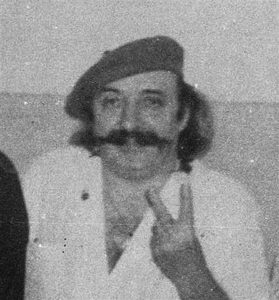 BIGOTE E’ GATO…IS A GREAT CHARACTER WHO LIVES THERE BY THE LUYANÓ …
BIGOTE E’ GATO…IS A GREAT CHARACTER WHO LIVES THERE BY THE LUYANÓ …
Bigote Gato real name, was Manuel Pérez Rodríguez and although his parents were originally from Candamo, in Asturias, he was actually born on December 13, 1910 in the neighboring town of Santullano de Las Regueras, where he gave the first kicks to honor the old knights of the Battle of Covadonga, and above all, the strawberries, fabadas and great ciders.
According to Rolando Aniceto who met him: “Mustache arrived in Havana in March 1924, aged fourteen, aboard the vessel Christopher Columbus. He came after the father’s trace and, in the end, he sought a destiny of his own. His first occupation was in an inn, where he earned twenty cents a day. However, there is more: he was a guaguero, a winemaker, he worked in an ice factory and he looked great in Cristina and Hatuey bars in Luyanó. He gave many missteps; never kick He began to become famous at La Tropical as a great dancer. They called him the “Gallego Caramelo”, for sticky. In these festivities he made a very good league with a butcher full of money: he invited him to drink and he introduced him to “jevitas” … Later, after 23 years in Cuba, he convinced him to inaugurate the bar-party on March 1, 1947 ‘Cat Mustache’.
THE WELL KNOWN BAR-TERTULIA “BIGOTE CATO”..
“This place was in Teniente Rey Street, today Brazil, number 308, corner Compostela, in the middle of Old Havana. There he created different salons such as ‘Ensueño’ and invented very funny propagandistic slogans: ‘Meet Cuba first, visit Cat’s Mustache later’; ‘A piece of our Motherland with all its products, a Cuban palm tree with all its customs’. His tavern was frequented by the neighbors of the block, small entrepreneurs, merchants and thirsty workers. It was not well seen in high society and it was not necessary.
“It was attended by bohemians like the poet Nicolás Guillén and the plastic artist Raúl Puig, who swore to me that he saw Ernest Hemingway order a Tropical 50 beer at his bar. It was never empty. The bacon and hams hung from the ceiling … the bottles of wine were everywhere … that was a spectacle.
“At the site they ate fish, Galician sardines (I think they were not so” Galician “) and tuna in industrial quantities. Ah …! He also invented drinks like ‘Attila in front of Rome’, ‘Wait for me in Heaven’ and ‘Cuba in Flames’ (in his old age he came up with one that immortalized the singer Farah Maria). He made a concoction aimed at couples in amatement unemployment using the aphrodisiac root of cashew, ginger, rum, garlic, lemon and sparrow brain extract, with the addition of the gonads of young crested crested rooster, ‘to avoid an opposite effect’ . Everything in the distilled cubanía “.
As you know, in the bar ‘Bigote Gato’ he established the Nightclub Club, with its owner at the head, whose members could be between eighteen and one hundred years old (“The most sane crazies in Cuba” as the writer described them at some time Jay Martinez). The peña came to gather more than 500 members who had to practice prudence and mutual respect; even in the prevention of possible fights, they were forbidden to discuss politics, religion or races. Of course, always moved between the wit and the disorder: they were half peaceful, half quarrelsome. The Club had a very special kind of Council of Ministers: the Minister of Transport was a rental driver, the Health Minister was a worker from Sarra’s pharmacy and so …
The most famous night owls were, in the first place, the Knight of Paris, great ally of Cat Mustache; Andarín Carvajal, very applauded for his raids throughout the capital; La Marquesa, the terror of the porters of the bars; Tarzan, who ate raw meat; Juan Cagao, of not very good smell, and one Juan Charrasqueado, tall, skinny, always dressed in a charro outfit, and determined to pay homage to the famous corrido of the same name that Jorge Negrete immortalized. Once a month, the clan organized a special dinner at three o’clock in the morning where they ate stewed tongue, tail of burning bull and pumpkin fruit with cheese.
Jack mustache, according to those who knew him, was seen as a protector of humanity, and in fact, he helped many needy, although, deep down, he was an eccentric and had to surround himself with these to attract attention. He was not a liar as they say, he was hyperbolic, he put everything big. His convertible chevrolet filled him with advertisements alluding to his business such as “I am the king of the Galician soup”; “Only bar where one enters sane and goes turulato” and “Only bar where you can eat ham Galician free.”
His walk through the Malecón de La Habana, accompanied by beautiful ladies, were true popular festivals. The little ones rode on the “Rocket of Cat’s Mustache”, as they called their vehicle, and they made a tremendous cacophony that made the most timid ones spicy on the feet. During the carnivals he participated a lot in the Sunday walks and in 1958 he won a race of “fotinguitos” that almost kills the spectators with laughter. When asked how he achieved such a feat he emphasized with irony: “Because my cart is from 26 …”, in a clear reference to Fidel’s July 26 Movement.
He and his entire gang achieved a great national diffusion when Gaspar Pumarejo directed on television of the fifties the humorous program the “Court of the crazy”, chaired by Bigote, which got the attention of those ventures who know that after the joke and the apparent unreason hide the great truths of life.
Unfortunately, in the sixties, (with the arrival of the revolutionary government) there ceased to exist his mundane canteen that passed to the state sector and he became an official of the gastronomic sector. He also married a Cienfuegos daughter of Asturians and had a poet and wandering son who was called ‘Profundo’, currently living in the United States. At first, he lived in the Calle Municipio, in Luyanó, and later, in the cast of La Granja del Cotorro, where he was struck by the occurrences: he put milk “cow juice” and ham “the bull of the stomach”. Sometimes, he commented: “I do not drink to forget, I drink, because I like it”. And, instantly, he became sententious: “Damage to me, as I fear you.”
He always had a reputation as a womanizer. As a confidence he whispered to his cronies that he adored the moon for being the lady of the stars. “In matters of love, he commented to Jorge Sariol in La Jiribilla, it is the donjuanes who sweat the most; It is not the same to open a notebook as to take out the tip of a pencil “.
In honor of this charming adventurer, present once in the Peel of Ofelita of the Federation of Asturian Societies of Cuba, was created, in Malecón number 117, the Humor Club “Bigote Gato”, with the cartoonist Francisco Blanco as president, in which the idea of putting a statue of him in the Plaza del Cristo, near the building where his epic bar was once, was handled.
Deceased already nonagenarian on July 11, 2003 (the Knight of Paris also dies a day like this in 1985), Bigote Gato barely exceeds seven in the examination of picturesque, anecdotal and small-town memory. The new generations have lost the thread of their tireless bustle and their disciples, lacking time, no longer have the thirst of the story and practice little the craft.
In any case, the true street myths never cease to be, because, as in this case, they represent the joy of living of the Cuban and his desire to overcome the moral tear with a sense of humor that pierces the cobblestones. Not for pleasure is still a well-remembered vitraco guaracha signed by Jesus Guerra in 1944 and played by the Puerto Rican Daniel Santos and the Sonora Matancera: Bigote Gato / is a great subject / who lives there by Luyanó / has the rogue / a mustache / that is everyone’s admiration).
To the delight of many, in January 2014 reappeared the bar Bigote Gato, on the corner of Teniente Rey (Brazil) and Aguacate, one block from the place where the protagonist of this story reigned. The new establishment, which occupies a nineteenth-century house rescued from ruin in its facade and ceilings, is a small place that tries to emulate in terms of intimacy with its predecessor and has a risky purpose: to rescue the CLUB OF THE NOCTAMBULES!
Agencies/OnCuba/ Orlando Carrio/ Extractos/ Internet Photos/ Arnoldo Varona/ www.TheCubanHistory.com
THE CUBAN HISTORY, HOLLYWOOD.




